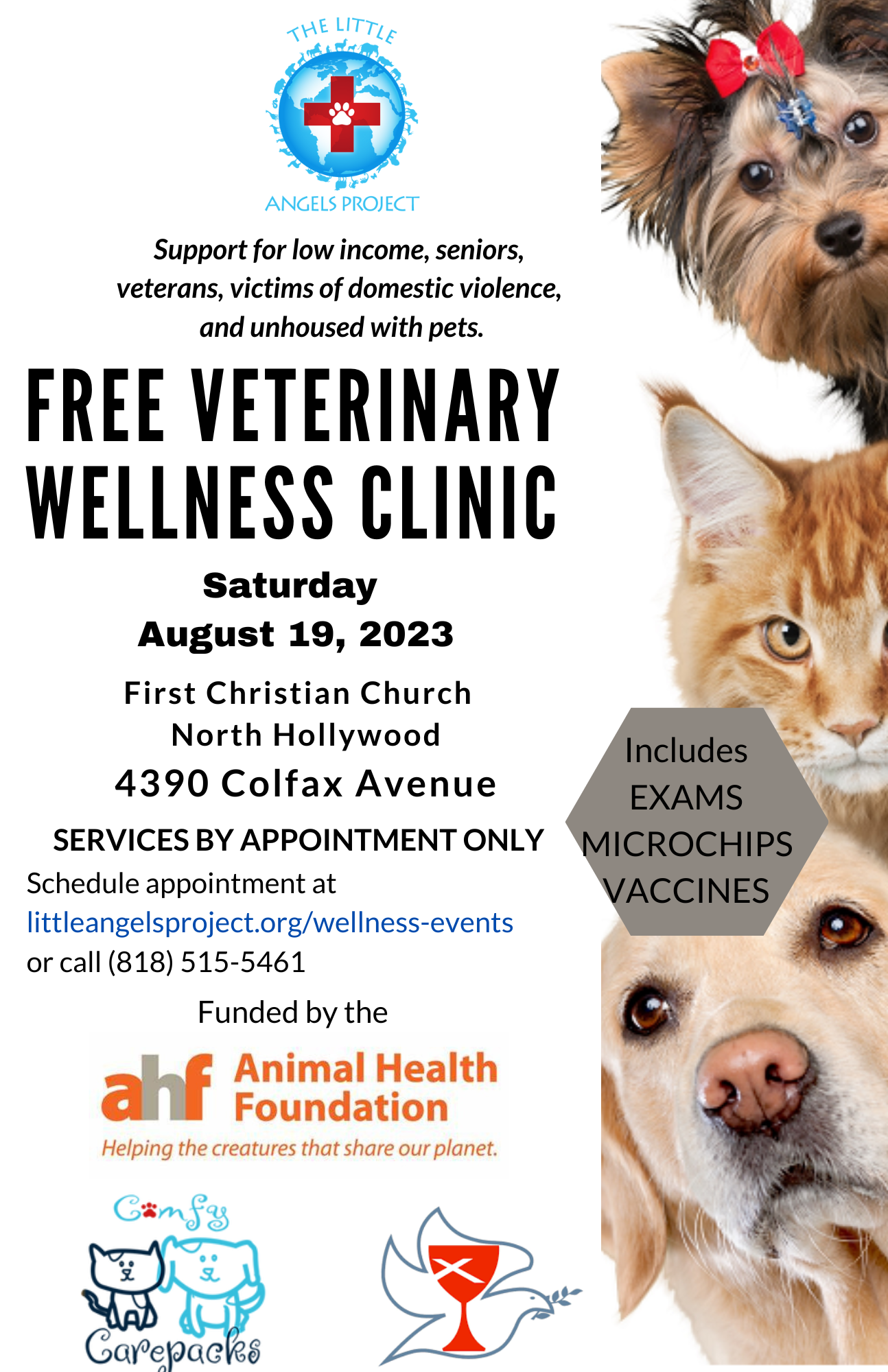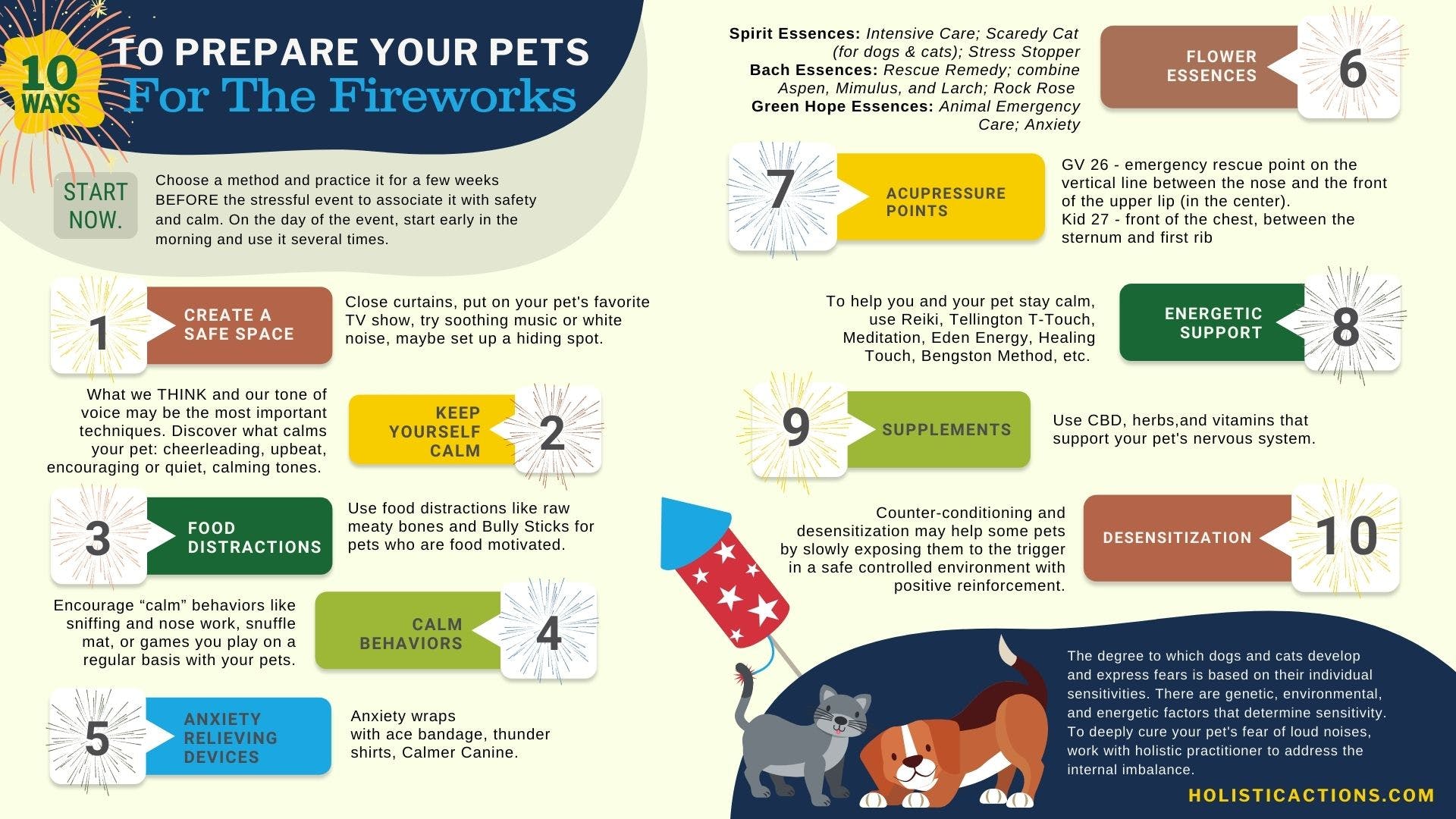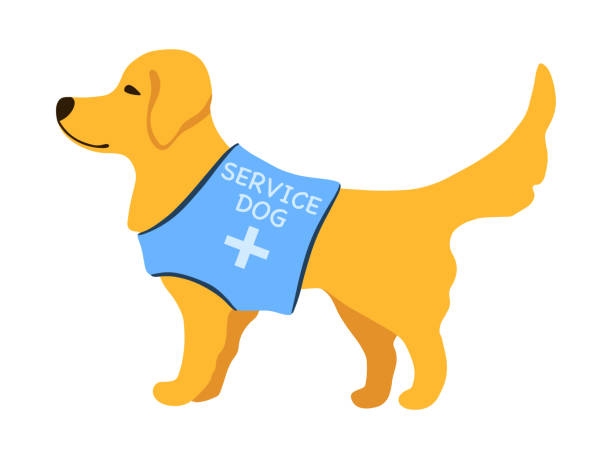Angel Fund Helps Mitzy, Blind Dog Diagnosed With IMHA

Helen Uitermark lives alone in her home in the San Gabriel Valley, except for her pets, including dogs large and small. About a year ago, she adopted Mitzy, “so, if nothing else, I can hug her on my lap.”
Mitzy is a West Highland White Terrier mix and is about the size of a Maltese-Poodle mix. She was just the right medicine to lift Helen out of a depression arising from her own medical problems.
Helen, is a senior citizen who often uses a cane or walker because of a broken ankle suffered nearly a year ago. Mitzy replaced two tuxedo cats that were apparently lost to coyotes.
Last spring, Helen said, “it was obvious that Mitzy wasn’t feeling well so I took her to Covina Animal Hospital. The diagnosis was glaucoma in her left eye.”
Dr. Karryssa Fenderson-Joseph, the hospital’s medical director, said that, when Mitzy’s condition did not improve with medical management, the best option she could offer was to remove the eye. The surgery took place a few days later.
Mitzy soon was able to run around in Helen’s backyard. “Everything was fine for several weeks,” she said. “Then, because Mitzy didn’t seem to be herself, I checked her, and the other eye seemed to have a white haze across it. I took her back to the hospital and she was diagnosed, again with glaucoma.” Dr. Fenderson said she recommended removal of Mitzy’s remaining eye after Helen told her that she didn’t want Mitzy to have on-going problems.
“After removal of the right eye, Dr. Fenderson had me come back several times because of an anemia condition (Immune-Mediated Hemolytic Anemia). I had never heard of it.
“Dr. Fenderson gave Mitzy a full-blood transfusion,” Helen said, “and she improved every week. We’ve been back to the hospital every month for a checkup. According to the doctor, the numbers have been holding so – unless something else happens – we’re good to go!”
Dr. Fenderson said that Mitzy has done so well since her transfusion that she is in remission and no longer is taking medication for IMHA.
Helen had been told about Angel Fund by friends and she asked Dr. Fenderson about it. “She immediately said: ‘Let me see what I can do.’ There was no further discussion about it but a few visits later, she said: ‘By the way, the grant has been approved.’ I almost danced out of her office! You have no idea how much I appreciate the Angel Fund grant.
“Dr. Fenderson has been so terrific, that’s where I will be going. It’s 15 miles from my home but, yes, she will be taking care of all my animals. I love her dearly.”
Mitzy seemed to be depressed after the second eye was removed. “She wasn’t interested in much and wasn’t even exploring. I was offered a kitten, about eight weeks old, and I said yes, since I’d lost the two cats last year.
“The kitten, Rusty, a male who is about six months old, and Mitzy get along fantastically. Mitzy’s depression has improved so much. It was wonderful to see. She gets around the house and backyard just fine. Every day her awareness seems to get better.”
Helen is getting used to dealing with a sightless Mitzy and she often forgets that her dog is blind. “She and I are getting accustomed to it. I can hear Mitzy on the other side of the door when I drive into the garage. It’s as if she’s trying to jump into my arms when I come through that door – then she does.”
But the household got a shock when Helen was pressured into accepting two Shi Tzu dogs that needed a new home. Helen said that she really did not want more pets, especially with a pinched sciatic nerve that added to her mobility problems. “They were absolutely loveable animals but it was too much,” she said.
A month after they arrived – the Shi Tzus were adopted by another family – much to Helen’s relief.
“My household is down to Mitzy and Rusty now. After the Shi Tzus left, Rusty came over to Mitzy when she was lying down and cuddled up to her. And she is walking through the house like it’s her domain again. I hope it is for many years to come!!”
Viva Raw Recall Notice One Lot Duck Recipes

RECALLS
Recall Due to Salmonella, Listeria monocytogenes Contamination.

This notice was provided to TruthaboutPetFood.com from Viva Raw pet food.
This notice is to inform you of a voluntary recall of: Viva Duck for Dogs (Ground),
Viva Duck for Dogs (Chunked), Viva Duck for Cats, Viva Pure Duck. The lot
under recall is Lot 22853. The product is distributed as frozen 1 lb bricks in
clear vacuum packaging. Viva started shipping this lot out on 10/24/23 and the last units were distributed on 12/06/23.
The FDA obtained and tested samples of Viva Duck for Dogs (Chunked) Lot
22853 after a consumer complaint and found that the samples were positive for
Salmonella, Listeria monocytogenes. Salmonella and Listeria monocytogenes
can affect animals eating the products and there is risk to humans from handling
contaminated pet products, especially if they have not thoroughly washed their
hands after having contact with the products or any surfaces exposed to these
products.
Healthy people infected with Salmonella should monitor themselves for some or
all of the following symptoms: nausea, vomiting, diarrhea or bloody diarrhea,
abdominal cramping and fever. Rarely, Salmonella can result in more serious
ailments, including arterial infections, endocarditis, arthritis, muscle pain, eye
irritation, and urinary tract symptoms. Consumers exhibiting these signs after
having contact with this product should contact their healthcare providers.
Pets with Salmonella and Listeria infections may be lethargic and have diarrhea
or bloody diarrhea, fever, and vomiting. Some pets will have only decreased
appetite, fever, and abdominal pain. Infected but otherwise healthy pets can be
carriers and infect other animals or humans. If your pet has consumed the
recalled product and has these symptoms, please contact your veterinarian.
Please check your freezer for any remaining products of Lot 22853. If you still
have products from the lot, complete this response form and we will reach out to
you to provide a refund for any remaining product—you can then destroy the
food in a way that children, pets, and wildlife cannot access. Make sure you do
not touch the contaminated food product with your bare hands. While wearing
gloves or using paper towels, place the contaminated food in a sealed plastic bag
and throw it in the garbage. Then you will need to sanitize your kitchen and any other area that may have come in contact with the contaminated product. Do not
sell or donate the recalled products. Do not feed the recalled product to pets or
any other animals.
Even if you do not have any packs of food remaining, please complete this
response form so that we can account for all customers that have received this
notice.
The health of your pet has always been Viva’s #1 priority and we have always
been committed to making safe & transparent pet food. We started this company
to change the industry and make the best pet food available. From choosing to
manufacture in a USDA facility & sourcing 100% human-grade ingredients, we
are committed to going above and beyond. We have conducted a detailed
root-cause analysis in our USDA facility to ensure we continue to exceed the
highest industry food safety standards & will continue to push the boundaries for
how safe, fresh pet food is made. If you have any questions regarding this notice,
feel free to email us at info@vivarawpets.com or call/text us at (919) 371-8882
between 9:00 am – 5:00 pm EST Monday to Friday.
This recall is being made with the knowledge of the Food and Drug
Administration.
How We Help

Angel Fund Grant Helps ‘Lucky Dog’ Get Surgery

Cheri Hanshaw, a fourth-grade teacher in Lancaster, owns a Shar Pei mix that she calls her lucky dog. “Star is my lucky dog because she gets everything to happen to her,” she said.
The last couple of years, she said, Star has had veterinary bills of about $10,000, include more than $3,000 a year ago when she was hospitalized with pancreatitis. The dog also has allergy problems. “We’ve had one thing after another with her,” Cheri said. “She’s usually at the vet’s every month.”
The latest iteration of her dog’s all too familiar relationship with veterinary medicine was recent surgery for a TPLO plate reaction, something that doesn’t happen often. Cheri did some research, which showed that it only occurs to about one in 50 dogs.
“Basically she had an infection from the plate in her knee and ite had to be removed,” Cheri said. “This is her second knee [to undergo TPLO surgery]. The left knee was fine and there was no problem after it was done a couple of years ago. And we had surgery in November for the right knee. It seemed fine and then after a few months, all of a sudden her leg started swelling up.”
Star, who is eight years old, is a patient of North Valley Veterinary Clinic in Lancaster. Dr. Eric Wright, who had done the TPLO surgery, told Cheri that the site infection could be treated with antibiotics but that it would continue to come back. “He recommended taking the plate out surgically so we don’t have to continue with these problems and spend all this money and then have to take it out surgically anyway,” she said.
Dr. John Chang, who assisted with the plate removal, told Cheri that he could see where an infection pocket was attached to a bolt on the plate.
The latest surgery took place in March. Because of Star’s history of medical problems, Cheri sought help from Angel Fund to help pay for the surgery. Dr. Misty Hirschbein, who sees Star for most of her appointments, told Cheri about Angel Fund and helped her apply. A grant of $1,000 was approved.
Cheri expressed gratitude to both Angel Fund and the North Valley Clinic, which matched the grant. But she also had to take out a loan to pay what she still owed. “I’m so in debt for this dog!” she said.
Star was still healing a month after the procedure, she said. “We had expected it would be healed by now,” Cheri said. “But the infection is almost gone.
“Star, the poor thing, has been living in a playpen since October. She has not been able to go outside to be a dog. She waits for us to come get her. So when I’m doing my school work, I’ll pull her out so she’s closer to me and not so isolated. I’m hoping she’ll be able to go back outside in a couple of weeks.”
Cheri lives with her daughter Kayla, who is a community college student. Her son, Zachary, She has a lives independently.
She previously had borrowed from her mother and taken out a loan from her credit union to help pay for her dog’s care. But Cheri is hoping things will change.
“I’m looking forward to being able to take Star on hikes again and to do the things that we used to do, like going to the beach. She’s almost there.”
If you would like to donate to the Animal Health Foundation to help more dogs like Star CLICK HERE or scan this QR Code

How to Be a Better Owner for a Pet Rabbit

Improve pet rabbit welfare in the home and vet clinic with simple techniques.
Updated July 7, 2023 | Source: Dr. Lori Gaskins for Psychology Today; Reviewed by Gary Drevitch

Source: Photo by Satyabratasm on Unsplash
by Lori Gaskins, DVM, DACVB, DACAW
Research regarding rabbit welfare and behavior indicates that there are many things that general practitioners and pet rabbit owners can do to improve the welfare of pet rabbits.
Veterinarians can play an active role in improving rabbit welfare during veterinary visits by using and recommending stress-reducing techniques. Some of these techniques include recommending owners bring a bonded companion to the exam; using aromatherapy; handling in a stress-free fashion; and offering treats and hiding places.
Veterinarians can also help prevent behavioral complaints of owners such as aggression, destruction, and house soiling. The majority of rabbits are fearful when lifted and handled, which can result in aggression to owners. Providing advice on reading the communication signals of rabbits and not handling them in ways that induce fear will decrease the risk of injuries to both the pet and the owner, and improve the human-animal bond. Other examples of responsible advice include housing the rabbit in a large and complex environment, getting rid of the food bowl and allowing the rabbit to forage for food, providing water in a bowl and not a water bottle, providing an appropriate litterbox, and always providing a companion and a hiding place. If veterinarians educate owners regarding their rabbits’ innate behaviors and emotions, this will increase the likelihood that each owner will provide a more welfare-friendly home for their pet.
How Rabbit Owners Can Improve Their Pets’ Welfare
Pet rabbit owners can improve their pet’s welfare in the home by providing their rabbit with companionship, foraging opportunities, hiding places, perches, digging boxes, positive reinforcement training, proper litterboxes, and a large enough enclosure to provide all of these things. Additionally, since the majority of rabbits are fearful when lifted and handled, these practices should be discontinued. An alternate method of moving the rabbit around is to train the rabbit to target an object, such as a finger or a stick with a ball on the end. The pet should be trained with positive reinforcement to place his nose on the target. This is done by luring the rabbit to the target with his favorite treat, then giving the treat if he sniffs or touches the target. Once the rabbit is trained to move to wherever the target is in order to touch it, the target can be placed wherever the owner wants the rabbit to go. This allows for fun interactions that can replace those that include picking the rabbit up and cuddling him.
Pet rabbit owners should work to decrease the stress of traveling, whether it’s for boarding or veterinary visits. The target training will help here, as the owner can place the target in a crate to get the rabbit crated for travel. Travel stress can also be decreased by always allowing bonded rabbits to travel together, using non-slip flooring in the crate, covering the crate with a towel, using aromatherapy such as lavender or valerian or blended essential oils, and providing favorite treats in the crate.
The 5 Domains of Welfare and the Pet Rabbit
Improving rabbit welfare can be accomplished using the framework of the 5 Domains of Welfare.
- Health: Provide timely veterinary visits to ensure the rabbit is physically and mentally healthy.
- Nutrition: Provide a nutritionally balanced diet and require rabbits to forage for food as nature intended.
- Environment: Provide natural light, appropriate temperatures, and hiding places.
- Behavioral Interactions: Provide a rabbit companion, stress-free interactions with humans, and a complex mentally stimulating environment which simulates the natural environment.
- Mental state: Provide a life that approximates what nature intended and therefore makes life worth living.

Dr. Lori Gaskins – Lori Gaskins is a veterinarian who is a diplomate of the American College of Animal Welfare and of the American College of Veterinary Behaviorists. She has been a practicing veterinarian for over 30 years and has been teaching animal welfare and behavior for 16 years. For more, see her ACVB Webinar on Rabbit Behavior and Welfare.
Angel Fund Helps Apollo Get Monthly Treatments


Ludovic Pathoux, who came to the United States from France in 2002, adopted Apollo, a beautiful white Pit Terrier, that he saw being neglected by a neighbor near his Los Angeles apartment some nine years ago.
“In 2014, while I was walking my American Bulldog Georgia, I saw Apollo behind the fence of one of my neighbors,” Ludovic said. “He was lying in the sun for hours at a time and was left out both day and night. I spoke to the neighbor about Apollo and his risk of getting skin cancer because of his exposure.”
The neighbor told Ludovic that she would like someone else to own the dog. “Despite already having a dog and difficult finances, I decided to adopt Apollo,” Ludovic said. “I simply fell in love with him and wanted to rescue him from his neglectful owner, even though I should not have had two dogs in my situation.”
Ludovic and the two dogs moved to an affordable cabin in the San Bernadino Mountains not long after Apollo joined the family. A couple of years later, Ludovic moved to an apartment in Yucaipa with Georgia and Apollo. A year later, he said, “my beloved Georgia died of cancer.”
Six months later, Apollo had a mole-like cancer on his leg that was removed by a veterinarian. And a few months later, Apollo was diagnosed with a tumor on his spleen and a splenectomy was performed to remove it. Georgia had a similar surgery a few years earlier.
In 2022, Apollo was diagnosed with chylothorax, a condition in which lymph fluids leak from his thoracic duct into the space around his lungs. Dr. George Makar at Yucaipa Animal Hospital made the diagnosis. Apollo is being treated there about once a month through thoracocentesis, a process in which a tube is inserted into his chest cavity after sedation to remove the fluids. The treatments started a year ago at a cost approaching $750 a month.
“Fortunately the procedure does not worsen his health nor does it cause pain or suffering,” Ludovic said. But the cost of his dog’s treatment is worrisome. Ludovic has had difficulty finding work as an organizer, who can make sense of your garage, pantry or spare room. (His website is http://www.ludovicorganizing.com.)
“I am not working every day so it’s up and down,” he said, and his erratic income prevents him from doing a lot of things he’d like to do, though he gives his dog’s health priority.
With Apollo’s crucial treatments in danger, Ludovic found Angel Fund with help from the Yucaipa hospital. He applied for a grant and Angel Fund provided $1,000 for Apollo, which was matched by the hospital.
“I sincerely thank the Angel Fund and Dr. Makar for generously helping me with this financial assistance,” Ludovic said. “Apollo greatly enjoys human beings and despite the invasive monthly treatments, he loves to go to the vet and is very excited to be around the assistants and technicians who give him lots of attention.
“My unconditional love for him has motivated me to do everything I can to increase his life expectancy.”
One of the reasons Ludovic does not want to return to France is that he would not be permitted to bring Apollo with him, nor could he have taken Georgia. He is intensely loyal to his animals.
But he said: “I choose to stay in the United States because I am all right here.” And he said, some 22 years ago “when I lived in Paris, I wasn’t happy.”

MARIJUANA, OTHER RECREATIONAL DRUGS DEBUT ON PET TOXINS TOP 10 LIST

By Coco Lederhouse June 20, 2023
For the first time, recreational drugs have made the American Society for the Prevention of Cruelty to Animals (ASPCA) Animal Poison Control Center’s (APCC) annual list of top toxins for pets. These drugs include marijuana-based substances, hallucinogenic mushrooms, and cocaine, which took the tenth spot on the list.
Over-the-counter medications, most often pain medications such as ibuprofen and acetaminophen; food, especially protein bars, xylitol gums, and grapes or raisins; and human prescription medications held the top three spots, respectively.
In 2022, the APCC team assisted 278,364 animals from the U.S., resulting in a nearly 5% increase in call volume when compared with 2021. The team received almost 11% more calls related to potential marijuana ingestion than in the previous year, and they have seen a nearly 300% increase in calls over the past five years, according to a recent APCC press release.
The most common cases the center saw involved pets ingesting marijuana-laced baked goods. In these cases, there may be additional toxic ingredients involved—such as chocolate, raisins, or xylitol—which result in a poorer prognosis. The most common clinical signs in dogs are ataxia or incoordination and lethargy or depression. Other common clinical signs are vomiting, urinary incontinence, increased sensitivity to motion or sound, head bobbing, dilated pupils, increased salivation, and a slower than normal heart rate.
Dr. Justine Lee, a board-certified veterinary emergency critical care specialist and toxicologist, explained that with the legalization of marijuana in several states and provinces, there has been an associated increased prevalence of accidental exposure to dogs, and children and less commonly cats.
“As a result, we need to be aware of this toxicant. Less frequently in the veterinary ER do I see cocaine or hallucinogenic mushrooms,” said Dr. Lee
According to a study published in April 2022 in PLoS One, researchers conducted a survey of veterinarians in Canada and the U.S. and found 226 of 251 toxicosis cases were among dogs. They also found that 116 of the cases were suspected to be from ingestion of edibles when the pet was unattended. Cannabis toxicosis was mostly diagnosed using supportive clinical signs, and the most common treatment was outpatient monitoring.
“The legalization of cannabis use in Canada and the US is likely an important factor associated with the increased cannabis toxicosis cases in pets; however, the legal status may also increase reporting,” the authors wrote. “The medicinal use of cannabis by pet-owners for pets may also contribute to a portion of the reported toxicoses. Most pets that experienced cannabis toxicosis recovered completely, suggesting that most cannabis toxicoses do not result in long-term ill effects.”
Dr. Lee said that pet owners are often unwilling to admit to illicit drug toxicosis.
“Judicious, nonjudgmental history taking, along with rapid recognition of clinical signs, is imperative to rapidly allow for decontamination—if appropriate—and treatment,” Dr. Lee said.
Can Your Dog Settle Down on Cue?

| An important skill for impulse control is the ability to settle down in the face of excitement. There is a lot of value in “installing an off switch” in your dog! It translates into the ability to get your dog to settle on cue even when she is very excited. This is especially useful when you want to let your dog know that an activity or a game has ended. Some high-energy dogs simply don’t know when to stop, and they can keep going long after you’ve already tired of the activity. An effective way to turn off activity in an action-loving dog is to teach an “all done” cue. This one doesn’t specifically tell the dog what to do – it just signals to her that the activity is over. Use any cue that makes sense to you, such as “All done!” or “That’s all!”. The sooner you “install” an off-switch in your high-energy, activity-persistent dog, the better. Remember, the longer the reinforcement history for persistence, the more persistent she’ll be. 1. Start teaching this behavior by engaging in your dog’s favorite activity – say, fetching a ball. After a reasonable period of fetch time, say “All done!” and put the ball away, out of sight, perhaps in a nearby cupboard. 2. Give your dog a reasonable alternative that she can do by herself, such as emptying a stuffed Kong. 3. Go sit down and occupy yourself with something, such as reading a book, watching TV, or web-surfing. 4. Ignore any attempts on your dog’s behalf to re-engage you, such as going to the cupboard and barking, or bringing you a different toy. 5. Don’t even repeat your off-switch cue, just ignore her. 6. Warn all other nearby humans to similarly ignore her attempts to engage them in activity when she’s been given the “All done” cue. Be prepared to quietly (so as not to get her aroused again) praise her when she finally lies down and starts to chew on the stuffed Kong. 7. Use your off-switch cue every time you end a play session with her favorite activity, and don’t give in if she persists. The more consistent you are, the sooner you will see her resign herself to the fact that the fun really is over when you say it is. If your dog does not like to fetch a ball, try another similar “get excited and settle” game such as running around together with a stop and settle. Or, play tug-and-drop, or try playing with a flirt pole (a toy on the end of a rope, which is fastened to a pole) to get your dog running, and then incorporate the stop and settle.Looking for more ways to teach your high-energy dog to chill out and relax? With Calm Down Rover from Whole Dog Journal, you’ll have instant access to vital training techniques. We all owe it to our dogs to understand why they act the way they do.www.whole-dog-journal.com |
How to Optomize Your Home for a Service Dog
Written By Holland Webb April 25, 2023
Article compliments of Today’s Homeowner – https://todayshomeowner.com/blog/guides/how-to-optimize-your-home-for-a-service-dog/

Why You Can Trust Us
Service dogs lead their owners into more functional and fulfilling lives. These loving, highly trained animals bear a lot of responsibility as they help perform a variety of day-to-day tasks for people with disabilities.
Most people know about guide dogs, but did you know that service dogs can also watch for signs of seizures, listen for sounds that people with hearing impairments may miss, or help open doors and carry objects for their handlers?
Service dogs are valued working partners and companions to over 500,000 Americans. Welcoming a new service dog is an exciting opportunity for you and your family.
It’s important to optimize your home for your service dog’s comfort, ease, and security. In this article, we’ll explore how to do that along with how to connect with organizations that provide service dogs and considerations for training your own service dog.
What is a Service Dog?
In addition to being great companions, working dogs perform a variety of jobs. They may aid in search-and-rescue operations, sniff out illegal substances, detect cancer, or provide therapy for people living in institutional settings.
Not every working dog is a service dog, though. The Americans with Disabilities Act specifically defines a service dog as one individually trained to do work or perform tasks for people with disabilities.
These disabilities may be physical, intellectual, psychiatric, or sensory. To qualify for a service dog, you typically need to work with an organization that serves people who live with your specific disability.
Common Service Dogs
The kind of disability you have partly determines which breed of dog you’ll get. The tiny Pomeranian, for example, lacks the physical strength to pull a wheelchair, but it has sharp hearing, a keen sense of smell, and enough dexterity to open cupboards and doors.
Labradors, Golden Retrievers, German Shepherds, and Great Danes may be employed for jobs that require physical strength and agility. Poodles are often used for tasks that require keen vision and problem-solving skills. A Pomeranian can work in tight, confined spaces due to its small size. Whatever the breed, a service dog must have qualities like intelligence, friendliness, a calm demeanor, and a love for work.
It takes about 18 months and can cost anywhere from $10,000 to $20,000 to train just one service dog. More than half of service dog candidates do not complete their training. Fortunately, these dogs can find homes as companions for loving families, while service dogs who complete their training programs go on to find work.
Optimizing Your Home for a Service Dog
When your new service dog arrives at your home, you’ll want it to feel welcome. That means optimizing your home and garden to make them accessible, navigable, and easy to work in.
Interior of the Home
Your dog needs clear, wide spaces that are simple to navigate and memorize. If you’ve had a disability for a long time, your home is probably already well-suited to your needs — and probably in good shape for your new dog, too. On the other hand, if your disability is recent, you may need to make some prompt modifications to your home.
Bathroom
The bathroom is probably the most hazardous room in your house. Every year about 235,000 people go to the emergency room because of an injury sustained in the bathroom. Small, slippery when wet, and filled with small objects in out-of-the-way cupboards, the bathroom can be tricky to manage.
Help your dog out by storing anything it needs to retrieve in a low storage container. If you use non-slip coverings on your floor, make sure they’re well-positioned to avoid either you or your dog getting tripped up.
Living Room
The clearer your floor is, the easier your dog will find it to navigate. Store remotes, magazines, throws, pillows, and other small items in baskets or bins that open from the top.
Keep personal belongings put away and debris picked up. In case of emergency, your dog will have a much easier time helping you get to safety.
You’ll also want to keep your living room well lit. If your dog will be turning lights on and off for you, be sure that switches are within easy reach of his nose or paw.
Bedroom
Most likely, your service dog will share your bedroom so it can respond to any nighttime emergencies. If your dog is a seizure detection specialist, it may need to sleep in the bed with you. If it will remain on the floor, however, make sure it has a designated sleeping spot.
You’ll also want to keep cords secured to the wall, slippers put in the closet, and pajamas picked up off the floor. Nothing should be scattered around that could distract the dog from its important job.
Kitchen
The kitchen is the primary workplace for many service dogs. Here, they may put away groceries, operate appliances, or alert their humans to alarms or smoke detectors. You’ll want to talk with your trainer about what your dog needs to do his specific jobs well.
For example, you might need to install tugs on the refrigerator doors or even remodel your kitchen so that countertops and cabinets are easy for your dog to access. Sometimes installing a lazy susan or pull-down shelf can be a great way to make your kitchen canine accessible without major renovations.
Doorways
Modern doorways are generally 32 inches wide or more to allow space for wheelchairs to get through. In an older home, however, you may be facing doors that are too small for you and your dog to pass through easily. Check with your dog’s trainer to see if your doors will be feasible for your animal to use. If not, you could have a remodeling project on your hands.
Some doorways are easy for an avid DIYer to enlarge on their own. If a door is part of a load-bearing wall, though, you need a licensed contractor to do the job.
Hallways
Narrow by nature, hallways can be a real challenge for your dog to navigate. Help your dog out by keeping them clean and clutter-free. You’ll also want to relocate furniture or decor that’s currently obscuring any part of the space.
Finally, keep this space well-lit. Maximize any natural light the space gets, and make sure overhead lights are clean and bright. If you haven’t already painted your hall a light color, now’s a good time to do that, too.
Exterior of the Home
Your dog will spend time outdoors. It’s important to keep your yard, sidewalk, and garage in good shape.
Garage and Driveway
If your dog will assist you in getting into and out of your car, it will need plenty of space to work. Trim any bushes or shrubs that extend into your driveway. You can also keep your space clear by moving other vehicles to another area outside your home. Most importantly, if your driveway is less than 12 feet wide, consider having it enlarged before your dog comes home.
Sidewalks and Pathways
Will your dog walk with you on the paths around your home or garden? If so, your sidewalk needs to be at least 36 inches wide if you use a wheelchair or 24 inches wide if you walk. Here again, you’ll want to trim any shrubs or other growth that may obscure the path or trip up your dog.
Yard
If your home has a yard, your dog needs a fence. A six-foot high barrier that discourages digging is enough for most dogs. You’ll want to check into the policies governing what kind of fence you can have in your area, and consult with the service dog trainer about the right kind of fencing for your dog’s breed and build.
General Accessibility Tips and Emergencies for Service Dogs
As you plan to welcome your service dog, look at your home as a whole space, not just a collection of individual rooms. What could you reorganize or remodel to help your dog live and work comfortably?
Avoid The Following For Your Service Dog
- Tight Spaces: Like people, dogs can’t work well in confined quarters. Find out your dog’s size, and then look for places that might feel like a tight squeeze.
- Obstructions: Your dog is probably much smaller and closer to the floor than you are. What might seem like a small obstruction to you could be a big impediment to it.
- Situations Your Dog Is Not Accustomed To: Dogs work best in predictable environments. Although service dogs are trained not to react to their surroundings, they will appreciate fewer distractions when working.
- Overstimulating Settings: While service dogs are chosen and trained to be gentle and quiet, they do experience a lot of work-related stress. Build in time for relaxation and exercise, and keep your dog out of intense environments as much as you can.
- Highly crowded Areas: Your service dog may be trained to lead you through a crowd or to provide crowd control if you have PTSD. You’ll probably want to keep your dog away from rowdy, crowded areas whenever possible, though.
Emergency Plan Tips
- Establish a safe spot for earthquakes. Make sure the area includes ample space for yourself, your dog, and any supplies both of you will need.
- Create a flood evacuation plan that your dog can follow.
- Designate an area with access to communication services during tornadoes or storms.
- Plan for power outages with an emergency kit that includes battery packs, medications, and first aid kits that the dog can reach.
Organizations that Help Find and Train Service Dogs
- The Seeing Eye
- Located in New Jersey, the Seeing Eye breeds and trains dogs to assist blind and visually impaired people. They also instruct dog owners in the proper use of handling service dogs.
- Good Fit For: People who are blind or visually impaired
- https://www.seeingeye.org/
- Assistance Dogs International
- Assistance Dogs International is a clearinghouse of programs that provide guide dogs, hearing dogs, and service dogs. The organization also accredits individual programs around the world.
- Good Fit For: Anyone looking for a service dog
- https://assistancedogsinternational.org/
- Leader Dogs for the Blind
- Fully funded by individuals and nonprofit donors, Leader Dogs for the Blind helps people who are blind or visually impaired live with independence and mobility.
- Good Fit For: People who are blind or visually impaired
- https://www.leaderdog.org/
- Epilepsy Foundation
- The Epilepsy Foundation provides resources for people interested in learning more about seizure dogs and their work. The foundation can connect you with an appropriate organization near your home.
- Good Fit For: People with epilepsy or a seizure disorder
- https://www.epilepsy.com/
- Canine Partners for Life
- Canine Partners for Life helps match people with disabilities with partner dogs. The organization provides canine partners for people with a wide variety of disabilities as well as people with diabetes and those who need a home companion.
- Good Fit For: Anyone with a qualifying disability
- https://k94life.org/
- Fidos for Freedom
- Fidos for Freedom provides trained service dogs, hearing dogs, therapy dogs, and combat-related PTSD dogs for people with disabilities, patients in health care facilities, and children with reading difficulties.
- Good Fit For: People living in the Baltimore-Washington, D.C. metropolitan community
- https://fidosforfreedom.org/
- Guide Dogs of America
- Based in Los Angeles, Guide Dogs of America breeds, raises, and trains service dogs for veterans, children with autism, and people with visual impairments. The organization also provides highly skilled dogs for jobs in hospitals, courtrooms, or classrooms.
- Good Fit For: Veterans, individuals with autism, or people with visual impairments
- https://www.guidedogsofamerica.org/
- Warrior Canine Connection
- Using a Mission Based Trauma Recovery (MBTR) model, Warrior Canine Connection helps warriors reconnect with their lives, families, friends, communities, and each other. Warriors both train and use the dogs as service partners.
- Good Fit For: Veterans, military families
- https://warriorcanineconnection.org/
- Puppies Behind Bars
- Founded in 1997, Puppies Behind Bars partners with incarcerated men and women to train service dogs and places the animals with qualifying applicants.
- Good Fit For: Veterans
- https://puppiesbehindbars.com/
- Canines for Disabled Kids
- Headquartered in Worcester, MA, Canines for Disabled Kids provides scholarships for children who need service animals. The organization also offers public education and training for families interested in acquiring a dog.
- Good Fit For: Children and families
- https://caninesforkids.org/
Tips on How to Train Your Own Service Dog
Service dogs do not have to be professionally trained. Anyone has the right to train a service dog.
However, before you begin training your own dog, make sure that he or she would make a good service dog. To be trained as a service dog the animal should meet the following criteria:
- Younger than six months old
- Spayed/neutered
- Properly sized for your needs
- Calm personality
- Long attention span
If you would like to train your own dog, consider the following best practices:
House Training
Like other house-dwelling animals, service dogs must be trained to do their business in a designated place outside. Crate-training is an effective approach since most dogs want to keep their crates clean. In the early days of training, reward the dog for going to the bathroom outside so it associates outdoor bathroom behavior with positive reinforcement.
Teaching Focus and Attentiveness Towards Handler
Your dog should focus on you — and only you — while it is working. Start this habit by encouraging the animal to make eye contact with you. Give the dog a treat for staying focused.
Off-leash Training
A service dog must respond to you whether it is on or off a leash. In a safe and controlled environment, you can take off the dog’s leash and give it simple commands. Reward or praise it for obeying those commands. Over time, you can move the activity to more-public situations.
Task-Oriented Training
Your dog is more than a companion. He or she has a job to do, and it’s up to you to train them how to do it. What do you need the animal to do?
- Be alert to seizures?
- Answer the door?
- Be alert to alarms?
- Carry groceries?
- Close doors?
- Guide you through a crowd?
- Be alert to allergens in food?
- Pull a wheelchair?
- Retrieve medication?
- Find help?
Socialization and Task-Focused Training
A successful service dog can stay focused on specific tasks even when it is out in social settings where there are distractions. Puppies should be acclimated to different sounds and people as much as possible and as early as possible. Also, be sure the dog is comfortable staying alone to minimize separation anxiety.
Disability Specific Training
Some service dogs work in disability-specific roles. For example, a hearing dog’s job is to listen for certain sounds and respond to them. A mobility assistance dog helps a human partner with limited mobility. You may want to work with a coach who can help you focus on building your dog’s unique skill set.
Emergency and Medication Focused Training
Medical alert dogs are trained to get help for those who need it. Some dogs also help manage their human’s medication. These dogs need to be individually trained to meet their job’s requirements.
Offer Relaxation Periods Between Training
Don’t forget to let your dog have fun. Off-duty time to relax, chew on a toy, get some exercise, or play with other pets is a critical part of training — and enjoying — your service dog.

